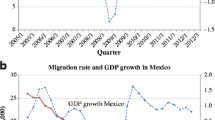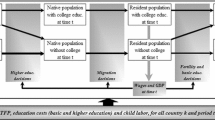Abstract
This article assesses whether international migration from Mexico affects the marital, fertility, schooling, and employment outcomes of the Mexican women who remain behind by exploiting variation over time as well as across Mexican states in the demographic imbalance between men and women. I construct a gauge of the relative supply of men for women of different age groups based on state-level male and female population counts and the empirically observed propensity of men of specific ages to marry women of specific ages. Using Mexican census data from 1960 through 2000, I estimate a series of models in which the dependent variable is the intercensus change in an average outcome for Mexican women measured by state and for specific age groups, and the key explanatory variable is the change in the relative supply of men to women in that state/age group. I find that the declining relative supply of males positively and significantly affects the proportion of women who have never been married as well as the proportion of women who have never had a child. In addition, states experiencing the largest declines in the relative supply of men also experience relatively large increases in female educational attainment and female employment rates. However, I find little evidence that women who do marry match to men who are younger or less educated than themselves.





Similar content being viewed by others
Notes
It is conceivable that the indirect effect on the likelihood of marriage of lowering one’s standards may overwhelm the negative direct effect of a decline in male availability operating through the offer arrival rate. This would be the case if a slight drop in standards greatly increases the pool of available men. Of course, this will depend on the actual form of the empirical quality distribution of male suitors. Regardless, these opposing direct and indirect effects suggest that in theory, the effect of relative male scarcity on female marriage probabilities can go in either direction. As I will soon show, however, most studies reviewed in this article have found that mate availability positively covaries with female marriage rates.
The microdata for these tabulations were downloaded from the IPUMS webpage at the University of Minnesota (http://www.ipums.org/).
The natural odds ratio of a male birth is slightly greater than 1, with sex ratios at birth without selective aborting around 1.05 (Almond and Edlund 2008).
The cross-state variation in emigration rates is a fascinating phenomenon in and of itself. A recent thorough empirical analysis of cross-state and cross-cohort migration rates finds that both economic push factors as well as network effects play important roles in determining the cross-state variation in migration rates depicted in Figs. 4 and 5. Hanson and McIntosh (2010) showed that interdecade migration rates from Mexican states between 1960 and 2000 depend positively on the size of particular birth cohorts (consistent with a labor market supply push argument) and negatively on initial per capita gross domestic product (GDP) and growth in per capita GDP. The authors also found substantial heterogeneity in these effects for states that are traditional sending states relative to states with lower historical migration rates. Specifically, they showed that these economic push and pull factors matter more in states with relatively high emigration rates in 1924 and states that are in close proximity to the main railroad passing through the country to the U.S. border (a transportation hub for recruiters of Mexican workers during the pre–World War II period (Cardoso 1980)). Independent of these factors, proximity to the U.S. border is not a particularly strong predictor of emigration rates.
It is also the case that the low sex ratios beyond age 15 observed in Mexico are unique relative to other Latin American countries. In an earlier working paper version of this study, I presented a comparison of Mexican sex ratios by age to those for four other Spanish-speaking Latin American countries. In all comparisons, Mexican sex ratios among those over age 15 are relatively lower, with particularly large differences relative to Panama, Costa Rica, and Venezuela, and more modest differences relative to Colombia. This is not particularly surprising given the relatively low rate of migration from these alternative countries to the United States.
The relevant first-stage models are presented in Table 1.
The results regarding work and school enrollment are certainly consistent with one another. Women are less likely to work when men are relatively abundant and more likely to be enrolled in school, suggesting that the need to work displaced formal education among the women analyzed. However, I also find completed schooling levels to be higher on average when men are relatively scarce. Although these findings regarding school enrollment and educational attainment may seem at odds with one another, it is important to keep in mind that the median woman aged 14–50 in Mexico has nine years of completed schooling, while the comparable median for early years in this analysis period is even lower. Hence, most women in our sample (the minimum age considered is 16) are several years beyond the termination of their formal education. It is therefore possible to see both a response of average years of school completion as well as change in enrollment akin to what is presented here. With poor marriage market prospects, women may increase their educational attainment from primary to middle school levels. At the same time, one can see a reduction in secondary and postsecondary enrollment for some because of the need to work in the formal economy.
References
Abramitzky, R., Delavande, A., & Vasconcelos, L. (2011). Marrying up: The role of sex ratio in assortative mating. American Economic Journal: Applied Economics, 3, 124–157.
Almond, D., & Edlund, L. (2008). Son-biased sex ratios in the 2000 United States census. Proceedings of the National Academy of Sciences, 105, 5681–5682.
Angrist, J. (2002). How do sex ratios affect marriage and labor markets: Evidence from America’s second generation. Quarterly Journal of Economics, 117, 997–1038.
Becker, G. S. (1991). A treatise on the family. Cambridge, MA: Harvard University Press.
Bohn, S., Lofstrom, M., & Raphael, S. (2012). Did the 2007 Legal Arizona Workers’ Act reduce the state’s unauthorized immigrant population (Working paper). Berkeley: University of California at Berkeley.
Borjas, G. J. (1995). Assimilation and change in cohort quality revisited: What happened to immigrant earnings in the 80s? Journal of Labor Economics, 13, 201–245.
Borjas, G. J. (2003). The labor demand curve is downward sloping: Reexamining the impact of immigration on the labor market. Quarterly Journal of Economics, 118, 1335–1374.
Butcher, K. F., & Piehl, A. M. (2007). Why are immigrants’ incarceration rates so low? Evidence on selective immigration, deterrence, and deportation (NBER Working Paper No. 13229). Cambridge, MA: National Bureau of Economic Research.
Card, D. (2001). Immigrant inflows, native outflows, and the local labor market impacts of higher immigration. Journal of Labor Economics, 19, 22–64.
Card, D. (2005). Is the new immigration really so bad? (NBER Working Paper No. 11547). Cambridge, MA: National Bureau of Economic Research.
Cardoso, L. (1980). Mexican emigration to the U.S., 1897–1931. Tucson, AZ: University of Arizona Press.
Catanzarite, L., & Ortiz, V. (2002). Too few good men? Available partners and single motherhood among Latinas, African Americans, and whites. Hispanic Journal of Behavioral Sciences, 24, 278–295.
Charles, K. K., & Luoh, M. C. (2010). Male incarceration, the marriage market and female outcomes. The Review of Economics and Statistics, 92, 614–627.
Chiappori, P. A., Fortin, B., & Lacroix, G. (2002). Marriage markets, divorce legislation, and households labor supply. Journal of Political Economy, 114, 175–201.
Fossett, M. A., & Kiecolt, K. J. (1990). Mate availability, family formation, and family structure among black Americans in nonmetropolitan Louisiana 1970–1980. Rural Sociology, 55, 305–327.
Fossett, M. A., & Kiecolt, K. J. (1993). Mate availability and family structure among African-Americans in U.S. metropolitan areas. Journal of Marriage and the Family, 55, 288–302.
Hanson, G. H., & McIntosh, C. (2010). The Great Mexican Emigration. The Review of Economics and Statistics, 92, 798–810.
Harknett, K. (2008). Mate availability and unmarried parent relationships. Demography, 45, 555–571.
Kilmarx, P. H., Zaidi, A. A., & Thomas, J. C. (1997). Ecological analysis of sociodemographic factors and the variation in syphilis rates among counties in the United States, 1984 to 1993. American Journal of Public Health, 87, 1937–1943.
Lichter, D. T., Anderson, R. N., & Hayward, M. D. (1995). Marriage markets and marital choice. Journal of Family Issues, 16, 412–431.
Lubotsky, D. (2007). Chutes or ladders? A longitudinal analysis of immigrant earnings. Journal of Political Economy, 115, 820–867.
Oppenheimer, V. K. (1988). A theory of marriage. The American Journal of Sociology, 94, 563–591.
Ottaviano, G. I. P., & Peri, G. (2007). Rethinking the gains from immigration: Theory and evidence from the U.S. (Working paper). Davis: Department of Economics, University of California at Davis.
Passsel, J., Cohn, D., & Gonzales-Barrera, A. (2012). Net migration from Mexico falls to zero—and perhaps less. Washington, DC: The PEW Hispanic Center.
Rao, V. (1993). The rising price of husbands: A hedonic analysis of dowry increases in rural India. Journal of Political Economy, 101, 666–677.
Rabell, C. (2001). Mexico census microdata: 1960, 1970, 1990, and 1995. In P. K. Hall, R. McCaa, & G. Thorvaldsen (Eds.), Handbook of international historical microdata for population research (pp. 141–148). Minneapolis: Minnesota Population Center.
Raphael, S., & Smolensky, E. (2009). Immigration and poverty in the United States. In M. Cancian & S. Danziger (Eds.), Changing poverty, changing policies (pp. 122–150). New York: Russell Sage Foundation.
Rosenfeld, M. J. (2008). Racial, educational and religious endogamy in the United States: A comparative historical perspective. Social Forces, 87, 1–31.
Sampson, R. J. (1995). Unemployment and imbalanced sex ratios: Race-specific consequences for family structure and crime. In M. B. Tucker & C. Mitchell-Kern (Eds.), The decline in marriage among African-Americans: Causes, consequences, and policy implications (pp. 229–260). New York: Russell Sage Foundation.
Smith, J. P., & Edmonston, B. (1997). The new Americans: Economic, demographic, and fiscal effects of immigration. Washington, DC: National Academy Press.
South, S. J. (1996). Mate availability and the transition to unwed motherhood: A paradox of population structure. Journal of Marriage and the Family, 58, 265–279.
South, S. J., & Lloyd, K. M. (1992). Marriage markets and nonmarital fertility in the United States. Demography, 29, 247–264.
South, S. J., & Lloyd, K. M. (1995). Spousal alternatives and marital dissolution. American Sociological Review, 60, 21–35.
Thomas, J. C., & Gaffield, M. E. (2003). Social structure, race, and gonorrhea rates in the southeastern United States. Ethnicity & Disease, 13, 362–368.
Wilson, W. J. (1987). The truly disadvantaged: The inner city, the underclass, and public policy. Chicago, IL: The University of Chicago Press.
Acknowledgments
This research was sponsored by a research grant from the Fundación BBVA. I gratefully acknowledge this generous support.
Author information
Authors and Affiliations
Corresponding author
Rights and permissions
About this article
Cite this article
Raphael, S. International Migration, Sex Ratios, and the Socioeconomic Outcomes of Nonmigrant Mexican Women. Demography 50, 971–991 (2013). https://doi.org/10.1007/s13524-012-0189-6
Published:
Issue Date:
DOI: https://doi.org/10.1007/s13524-012-0189-6




